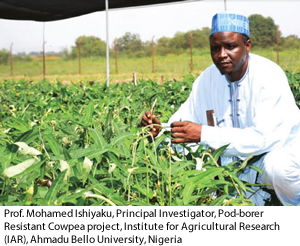CROP BIOTECH UPDATE
---------------------------------------------------------------------------
A weekly summary of world developments in agri-biotech for developing countries, produced by the Global Knowledge Center on Crop Biotechnology, International Service for the Acquisition of Agri-biotech Applications SEAsiaCenter (ISAAA)
---------------------------------------------------------------------------
January 30, 2019
In This Week’s Issue:
News
Global
• Increased Knowledge about GM Foods Leads to More Positive Attitudes, Study Says
Africa
• NBMA Solicits Public Comment on the Application for GM Cassava Confined Field Trial
• Nigeria Approves First GM Food Crop for Open Cultivation
Americas
• Purdue Research Team Nails Down Important Plant Compound Pathway
Asia and the Pacific
• Researchers Discover Molecular Basis of Odor Detection in Plants
• Study Reveals Philippine Lawyers' Perception and Attitude Towards Agri-biotech
Europe
• 'Noisy' Gene Atlas to Explain How Plants Survive Environmental Changes
• New Insight into Unique Sugar Transport in Plants
Research
• Scientists Characterize Green Tea Genes Encoding Vital Enzymes
New Breeding Technologies
• Japanese Scientists Identify Peptide and Receptor Responsible for Plant Root Spacing
• Gene Editing Can be Used to Make Wheat with Safe Gluten
Beyond Crop Biotech
• Use of CRISPR to Control Pest Populations
• Transgenic Pigs Expressing β-xylanase Show Improved Nutrient Utilization
Document Reminders
• Good Enough to Eat?: Next Generation GM Crops
----
NEWS
----
Global
INCREASED KNOWLEDGE ABOUT GM FOODS LEADS TO MORE POSITIVE ATTITUDES, STUDY SAYS
 A study conducted by a group of researchers from the United States, The Netherlands, and United Kingdom reports that teaching people about the science behind genetically modified (GM) foods leads to more knowledge about and more positive attitudes toward GM, greater willingness to eat GM foods, and to perceiving GM foods as less risky.
A study conducted by a group of researchers from the United States, The Netherlands, and United Kingdom reports that teaching people about the science behind genetically modified (GM) foods leads to more knowledge about and more positive attitudes toward GM, greater willingness to eat GM foods, and to perceiving GM foods as less risky.
GM crops and GM foods are often met with harsh public opposition, though little research has been done to understand why this is. The research team conducted four studies which looked at lack of literacy of GM technology as a strong and unique predictor of GM food skepticism.
Studies 1 and 2 showed that knowledge of GM technology is a unique predictor of GM food attitudes above general science knowledge and demographic controls. Study 3 confirmed that the unique predictive value of GM-specific knowledge was the same in the US, the UK, and the Netherlands. The fourth and final study sought to overcome this lack of knowledge by teaching people the basic science behind GM technology using a five-week, longitudinal experimental design.
Results showed that learning about the science behind GM technology leads to more positive explicit attitudes towards GM foods, greater willingness to eat GM products, and lowered perceptions of GM foods as risky. These results provide a relatively simple mold for future interventions to overcome GM skepticism, suggesting that researchers and scientists may wish to focus on communicating the basic science behind GM technology and increasing science literacy.
For more details, read the paper's pre-print version.
Africa
NBMA SOLICITS PUBLIC COMMENT ON THE APPLICATION FOR GM CASSAVA CONFINED FIELD TRIAL
The National Biosafety Management Agency of Nigeria published the application dossier for confined field trial of genetically engineered cassava with increased starch yield. The dossier, submitted by the International Institute of Tropical Agriculture (IITA), is available for public comment until February 4, 2019.
The purpose of the confined field trial is to evaluate the performance of GM cassava on the field and gather data on its starch yield, particularly in its storage roots. It is expected that the GM plants to be generated would produce more and/or bigger storage roots with higher starch content per storage root dry weight.
The public display of the dossier is in accordance with the NBMA Act 2015. View the application dossier from IITA.
NIGERIA APPROVES FIRST GM FOOD CROP FOR OPEN CULTIVATION
 Nigeria is on the path to becoming the first country ever to cultivate biotech cowpea after the country's biosafety agency granted approval for the crop's cultivation by farmers. This development adds a new crop to the global biotech basket from Africa. The National Biosafety Management Agency (NBMA) permitted the Institute for Agricultural Research (IAR) to commercially release Pod Borer-Resistant Cowpea (PBR Cowpea)-event AAT709A, genetically improved to resist lepidopteran insect pest Maruca vitrata. The permit is valid until the end of 2022.
Nigeria is on the path to becoming the first country ever to cultivate biotech cowpea after the country's biosafety agency granted approval for the crop's cultivation by farmers. This development adds a new crop to the global biotech basket from Africa. The National Biosafety Management Agency (NBMA) permitted the Institute for Agricultural Research (IAR) to commercially release Pod Borer-Resistant Cowpea (PBR Cowpea)-event AAT709A, genetically improved to resist lepidopteran insect pest Maruca vitrata. The permit is valid until the end of 2022.
In a Decision Document dated January 22, 2019, the Agency said the issuance of the permit was made after taking into consideration the advice of National Biosafety Committee, National Biosafety Technical sub-committee and the risk assessment and risk management report provided by IAR, the applicant.
"After a thorough analysis of the application dossier, Risk Assessment and Risk Management Plan prepared in connection with assessment of the application, it is unlikely that the proposed release will have adverse impact on the environment and human health," read part of the document.
The approval is a culmination of more than nine years of intensive trials into genetically modified (GM) cowpea that can resist Maruca vitrata pod borer, an insect that can cause up to 80 percent yield loss. The release is a relief to millions of Nigerian farmers who depend on cowpea for food and income. Results from the research, led by Nigeria's Institute for Agricultural Research in partnership with the African Agricultural Technology Foundation (AATF), have shown that Bt cowpea will reduce the use of pesticides from eight to about two sprays per season and increase yield up to 20 percent. This means that Nigeria will record a revenue increase of more than N48 billion ($132 million) annually from cowpea.
This is the second GM crop to be released in Nigeria after Bt cotton which was approved for open field cultivation last year.
For more on the project contact Prof. Mohammad Ishiyaku at mffaguji@hotmail.com. View the decision document from NBMA.
Americas
PURDUE RESEARCH TEAM NAILS DOWN IMPORTANT PLANT COMPOUND PATHWAY
A research team from Purdue University led by Natalia Dudareva has described a complete second pathway used by plants to produce phenylalanine, a compound important for all living organisms.Scientists have long accepted that plants use one biological pathway to produce phenylalanine, but this did not explain all observed production of the compound. Dudareva's team recently discovered the final step in the alternative pathway and have identified the remaining steps. The key finding, as reported in the journal Nature Communications, is that the entire process happens in the cytoplasm rather than cell organelles called plastids.
"It splits completely at a different point than predicted, and the whole pathway is localized in cytoplasm. This was unexpected," Dudareva said. She added that the gene responsible for the committed step has been known for 20 years and was never, until now, considered to be involved in production of phenylalanine.
For more details, read the news article from Purdue University.
Asia and the Pacific
RESEARCHERS DISCOVER MOLECULAR BASIS OF ODOR DETECTION IN PLANTS
Plants can smell, too, even without noses. This ability of plants to smell is in their genes and researchers have discovered the first steps of how information from odor molecules changes gene expression in plants. This discovery by researchers from the University of Tokyo led by Professor Kazushige Touhara, is the first to reveal the molecular basis of odor detection in plants and was more than 18 years in the making.
Plants detect odor molecules known as volatile organic compounds, which are essential for survival strategies, including attracting birds and bees, deterring pests, and reacting to disease in nearby plants. These compounds also give distinctive scents. The researchers exposed tobacco cells and 4-week-old tobacco plants to different volatile organic compounds. They discovered that odor molecules change gene expression by binding to other molecules called transcriptional co-repressors that can turn genes on or off.
Touhara hopes to apply their discoveries to influence crop quality or character without the complications of gene editing or pesticide use. He said that farmers could spray their fields with an odor associated with a desired plant behavior. For example, an odor that triggers to change the taste of their leaves to deter insects.
For more details, read the press release from The University of Tokyo.
STUDY REVEALS PHILIPPINE LAWYERS' PERCEPTION AND ATTITUDE TOWARDS AGRI-BIOTECH
 Results of the study, "Legal Discourse on Agri-Biotechnology: Implications to Lawyers' Engagement in Biotechnology in the Philippines" were presented to scientists and experts as well as representatives from the academe, national and international agencies/institutions, and partners from the biotech community during the Agriculture and Development Seminar Series (ADSS) of the Southeast Asian Regional Center for Graduate Study and Research in Agriculture (SEARCA) on January 29, 2018.
Results of the study, "Legal Discourse on Agri-Biotechnology: Implications to Lawyers' Engagement in Biotechnology in the Philippines" were presented to scientists and experts as well as representatives from the academe, national and international agencies/institutions, and partners from the biotech community during the Agriculture and Development Seminar Series (ADSS) of the Southeast Asian Regional Center for Graduate Study and Research in Agriculture (SEARCA) on January 29, 2018.
The study was a joint collaboration of SEARCA Biotechnology Information Center (SEARCA BIC) and the College of Development Communication at the University of the Philippines Los Baños. It focused on analyzing the Philippine lawyers' understanding and attitude towards agri-biotechnology and how these may serve as basis for defining their engagement in agri-biotech development.
Results reveal that despite having a low level of familiarity with key terms (i.e., genes, viruses, Golden Rice, GMO contamination, etc.), processes, and the existence of agri-biotech regulations in the country, lawyers still favor the application of agri-biotech in food and medicines provided that proper precautions are taken such as educating the public on its pros and cons, addressing risks of the technology, and having a structured regulatory process, among others. While lawyers perceive agri-biotech as an interesting topic, they do not find it as a lucrative area of legal practice as yet. Nevertheless, they are open to expand their knowledge on the subject, collaborate with scientists, and actively participate in regulating agri-biotech products in the country.
The researchers also analyzed the content of legal documents related to the Bt eggplant case and found that there is a need to improve the level of science literacy among the judiciary based on the legal arguments raised during the trial. Consequently, this lack of understanding on the nature of GM crops had implications on their decision to stop the Bt eggplant field testing in the Philippines in 2015, but was overturned in 2016.
For more updates about biotech news in the Philippines, visit the SEARCA BIC website.
Europe
'NOISY' GENE ATLAS TO EXPLAIN HOW PLANTS SURVIVE ENVIRONMENTAL CHANGES
Scientists at the Sainsbury University (SLCU) have built a gene expression atlas that maps the ‘noisy genes' of genetically identical plants.
Using thale cress seedlings, the researchers conducted RNA-sequencing on individual seedlings every two hours over a 24-hour period and analyzed the variability for 15,646 individual genes in the plant's genome. The researchers found that around 9% (1,358 individual genes) of the genes in identical plants are highly variable in the way they behave. Interestingly, many of these highly variable or 'noisiest' genes help a plant respond to its environment, including genes involved in reacting to light, temperature, pathogens, and nutrients.
The study also identified factors that might increase gene expression variability. Highly variable genes tend to be shorter, to be targeted by a higher number of other genes (transcription factors) and to be characterized by a ‘closed' chromatin environment (which is an environment that allows gene expression to be altered by attaching additional molecules during the gene reading process (transcription) without actually changing a cell's DNA).
SLCU Research Group Leader Dr. James Locke, said the data was a significant new resource for further research. 'This is an important resource for scientists studying how genetically identical plants survive fluctuating environments and provides a basis for future work looking at how genetic and epigenetic factors regulate variability for individual genes.'
For details, read the research news at the University of Cambridge website.
NEW INSIGHT INTO UNIQUE SUGAR TRANSPORT IN PLANTS
A research group at Aarhus University in Denmark has explained the structure of a sugar transport protein (STP) that is unique to plants.
STP is unique to plants, and is important for the proper development of plant organs such as pollen. Sugar is generated in plants through photosynthesis and transported as sucrose to plant parts through the sieve tissue. In sink tissues such as roots, pollen, and fruits, the plant absorbs sugar either as sucrose or, after cleavage, as glucose and fructose.
With the new structure, the researchers show that the overall form of STPs resembles other sugar transporters such as those in humans. A new domain that has not been described before is also being investigated by the group. The researchers made a version of the protein in which this was removed. When this was done, the protein lost its ability to transport sugar efficiently at certain pH values.
Assistant Professor Bjørn Panyella Pedersen said that the results of their study are related to how many of the plants' organs develop correctly, and at the same time have proved to be an important contribution to plants' response to fungal attacks.
For more details, read the news article from Aarhus University.
Research
SCIENTISTS CHARACTERIZE GREEN TEA GENES ENCODING VITAL ENZYMES
Catechins are major components of the flavonoid pathway in tea in which they are synthesized in four distinct ways under the direct catalysis of two enzymes, leucoanthocyanidin reductase (LAR) and anthocyanidin reductase (ANR).
Vietnamese scientists conducted the cloning and sequence analysis of genes encoding ANR and LAR (namely, CsANR2 and CsLAR1) from the Green Trung Du cultivar. The length of CsANR2 gene is 1,014 bp, encoding 337 amino acids. Comparative analysis of the nucleotide sequences showed that there was limited difference between the CsANR2 gene in the green tea cultivar and the CsANR2 sequence published in Genbank, with nucleotide identity of 98.9–99.6%, and amino acid similarity of 95.7–99.5%. CsANR2 has two major functional regions, the N-terminal glycine-rich domain that functions in association with NAD or NADP (GGTGFVAA); the substrate-specific domain has amino acids involved in enzyme catalysis (S130, Y167 and K171). The results showed that the difference in nucleotide sequences does not lead to amino acid change in the important functional domains of CsANR2.
The length of CsLAR1 gene is 1,029 bp, encoding 342 amino acids. The difference between CsLAR1 of green Trung Du tea and those published in GenBank ranged from 96.3–100% in nucleotide, and 88.3–100% in amino acid sequence. CsLAR1 contains 3 conserved amino acid motifs among species, RFLP, ICCN and THD. However, the ICCN motif of CsLAR1 from green Trung Du tea has a distinct amino acid from the published sequences (I153T). Analysis of the functional domains of CsLAR1 showed that CsLAR1 in tea was conserved in the amino acids linked to the substrate, and the N-terminal glycine-rich domain binding to NADP has a modified amino acid (GACGFIG). More research is needed to study how these amino acid modifications affect CsANR2 and CsLAR1 enzymatic activities.
For more information, read the article in Vietnam Journal of Biotechnology.
New Breeding Technologies
JAPANESE SCIENTISTS IDENTIFY PEPTIDE AND RECEPTOR RESPONSIBLE FOR PLANT ROOT SPACING
A team of Japanese scientists has identified a peptide and its receptor that direct lateral roots into growing with the right spacing. The scientists used the plant model Arabidopsis, and were able to identify that the overexpression of a certain gene, the TOLS2, located in the lateral root founder cells and root germ of the plant, can inhibit the formation of lateral root cells.
Further investigation proved that the receptor of the TOLS2 gene is the RLK7, a protein commonly expressed in the inner sheath of the roots, endodermis, and dermal layer of the plant. Interestingly, the RLK7 expression is not found in the lateral root founder cells and are likely to suppress the formation of lateral roots in cells adjacent to lateral root founder cells. Then using CRISPR-Cas9 technology, the scientists were able to confirm that the TOLS2 peptide and the RLK7 receptor are important in preserving the correct spacing between lateral root founder cells.
According to the researchers, these findings can lead to more studies in the future that will help scientists understand root formation mechanisms of plants and trees, and potentially control their root formation.
Read more from Kobe University and Developmental Cell.
GENE EDITING CAN BE USED TO MAKE WHEAT WITH SAFE GLUTEN
 Gluten-free diet is a hot trend among many health conscious individuals. However, this diet is designed for people with celiac disease (CD), or those who cannot tolerate a certain type of gluten in their digestive system. Gluten, a protein found in wheat, barley, rye, and other related species, acts as glue when cooked or baked that holds breads and cakes together as they rise. The specific type of gluten responsible for causing adverse reactions are called gliadins.
Gluten-free diet is a hot trend among many health conscious individuals. However, this diet is designed for people with celiac disease (CD), or those who cannot tolerate a certain type of gluten in their digestive system. Gluten, a protein found in wheat, barley, rye, and other related species, acts as glue when cooked or baked that holds breads and cakes together as they rise. The specific type of gluten responsible for causing adverse reactions are called gliadins.
Researcher Aurélie Jouanin from Wageningen University and Research described the use of CRISPR-Cas9 to precisely modify gliadin genes and remove the immunogenic epitopes, to develop wheat with safe gluten. As a proof of principle, she developed wheat plants wherein some of the gliadin genes were modified or deleted. These edited wheat plants are not yet safe for CD patients, as there is a large number of gluten genes present in wheat and not all gluten genes have been targeted. She has also developed high-throughput methods to determine which genes have been modified and which remain to be edited.
Read more from Wageningen University and Research.
Beyond Crop Biotech
USE OF CRISPR TO CONTROL PEST POPULATIONS
Researchers from the University of California-San Diego used the CRISPR gene editing tool to devise a method of altering key genes that control insect sex determination and fertility. This method enables a low-cost pest control solution that can be used in the future. A detailed description of the technique is published in Nature Communications.
The new technique called precision-guided sterile insect technique (pgSIT) is different from gene drive systems that continuously propagate genetic alterations from generation to generation. In the new technique, when pgSIT-derived eggs are introduced into targeted populations, only adult sterile males emerge, creating a dead end to the population. It has been tested to be effective in fruit flies, and the researchers are planning to apply it to mosquito species responsible for causing life-threatening diseases such as Dengue Fever, Zika, and Yellow Fever.
Read more from UC San Diego News Center.
TRANSGENIC PIGS EXPRESSING β-XYLANASE SHOW IMPROVED NUTRIENT UTILIZATION
Scientists from South China Agricultural University and Longyan University in China developed transgenic pigs with better nutrient utilization. The results are published in Transgenic Research.
Xylan is an anti-nutritional factor present in pig's feed. To improve the digestibility of xylan and the absorption of nutrients, transgenic pigs expressing β-xylanase gene (xynB) from Aspergillus Niger CGMCC1067 in the parotid gland were developed.
Results showed that in the four live transgenic founders, β-xylanase activities in the saliva were improved. Compared with non-transgenic pigs, the content of crude protein (CP) in feces was significantly reduced and the digestibility of gross energy and CP in F1 transgenic pigs was increased. These findings show that transgenic pigs producing β-xylanase from parotid gland can reduce the anti-nutritional effect in animal diet and improve the utilization of nutrients.
Read the research article for more details.
Document Reminders
GOOD ENOUGH TO EAT?: NEXT GENERATION GM CROPS
So long as you have food in your mouth, you have solved all questions for the time being. So begins Good Enough to Eat?: Next Generation GM Crops, which challenges Kafka's culinary sentiments and proceeds to unravel our complex and deeply personal relationship with food.
The book is authored by Ian Godwin, Professor in Plant Molecular Genetics and Director of Centre for Crop Science at The University of Queensland. It is published by the Royal Society of Chemistry, and includes interviews from both sides of the (farmyard) fence; from biologists to farmers and nutritionists to activists, charting the history of GM foods from the laboratory to the global dinner plate.
The author chronicles the social, political and philosophical arguments for and against GM crops, and the science and knowledge behind the battle for global food security and sustainability.
For more details about this book, visit the Royal Society of Chemistry.
(c) 2024. ISAAA.
 A study conducted by a group of researchers from the United States, The Netherlands, and United Kingdom reports that teaching people about the science behind genetically modified (GM) foods leads to more knowledge about and more positive attitudes toward GM, greater willingness to eat GM foods, and to perceiving GM foods as less risky.
A study conducted by a group of researchers from the United States, The Netherlands, and United Kingdom reports that teaching people about the science behind genetically modified (GM) foods leads to more knowledge about and more positive attitudes toward GM, greater willingness to eat GM foods, and to perceiving GM foods as less risky.  Nigeria is on the path to becoming the first country ever to cultivate biotech cowpea after the country's
Nigeria is on the path to becoming the first country ever to cultivate biotech cowpea after the country's  Results of the study, "Legal Discourse on Agri-Biotechnology: Implications to Lawyers' Engagement in Biotechnology in the Philippines" were presented to scientists and experts as well as representatives from the academe, national and international agencies/institutions, and partners from the biotech community during the Agriculture and Development Seminar Series (ADSS) of the Southeast Asian Regional Center for Graduate Study and Research in Agriculture (SEARCA) on January 29, 2018.
Results of the study, "Legal Discourse on Agri-Biotechnology: Implications to Lawyers' Engagement in Biotechnology in the Philippines" were presented to scientists and experts as well as representatives from the academe, national and international agencies/institutions, and partners from the biotech community during the Agriculture and Development Seminar Series (ADSS) of the Southeast Asian Regional Center for Graduate Study and Research in Agriculture (SEARCA) on January 29, 2018.  Gluten-free diet is a hot trend among many health conscious individuals. However, this diet is designed for people with celiac disease (CD), or those who cannot tolerate a certain type of gluten in their digestive system. Gluten, a protein found in
Gluten-free diet is a hot trend among many health conscious individuals. However, this diet is designed for people with celiac disease (CD), or those who cannot tolerate a certain type of gluten in their digestive system. Gluten, a protein found in